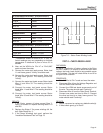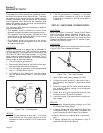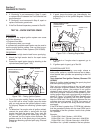
Section 7
DIAGNOSTIC TESTS
be indicated by excessive current draw or no
RPM.
3. A defective Starter Motor switch.
4. Broken, damaged or weak magnets.
5. Starter drive dirty or binding.
DISCUSSION:
Test 21 verified that Printed Circuit Board action is
delivering DC voltage to the Starter Contactor Relay
(SCR). Test 22 verified the operation of the SCR. Test
23 verified the operation of the Starter Contactor (SC).
Another possible cause of an “engine won’t crank”
problem is a failure of the Starter Motor.
PROCEDURE:
The battery should have been checked prior to this
test and should be fully charged.
Set a VOM to measure DC voltage (12 VDC).
Connect the meter positive (+) test lead to the Starter
Contactor stud which has the small jumper wire con-
nected to the Starter. Connect the common (-) test
lead to the Starter Motor frame.
Set the Start-Stop Switch to its “Start” position and
observe the meter. Meter should Indicate battery volt-
age, Starter Motor should operate and engine should
crank.
RESULTS:
1. If battery voltage is indicated on the meter but
Starter Motor did not operate, remove and bench
test the Starter Motor (see following test).
2. If battery voltage was indicated and the Starter
Motor tried to engage (pinion engaged), but
engine did not crank, check for mechanical bind-
ing of the engine or rotor.
If engine turns over slightly, go to Test 32 “Check and
Adjust Valves.”
NOTE: If a starting problem is encountered, the
engine itself should be thoroughly checked to
eliminate it as the cause of starting difficulty. It is
a good practice to check the engine for freedom
of rotation by removing the spark plugs and turn-
ing the crankshaft over slowly by hand, to be sure
it rotates freely.
*
WARNING! DO NOT ROTATE ENGINE WITH
ELECTRIC STARTER WITH SPARK PLUGS
REMOVED. ARCING AT THE SPARK PLUG
ENDS MAY IGNITE THE GASOLINE VAPOR
EXITING THE SPARK PLUG HOLE.
Figure 7-21. – Starter Motor (SM)
CHECKING THE PINION:
When the Starter Motor is activated, the pinion gear
should move and engage the flywheel ring gear. If the
pinion does not move normally, inspect the pinion for
binding or sticking.
PINION
Figure 7-22. – Check Pinion Gear Operation
TOOLS FOR STARTER PERFORMANCE TEST:
The following equipment may be used to complete a
performance test of the Starter Motor:
❏ A clamp-on ammeter.
❏ A tachometer capable of reading up to 10,000 rpm.
❏ A fully charged 12-volt battery.
MEASURING CURRENT:
To read the current flow, in AMPERES, a clamp-on
ammeter may be used. This type of meter indicates
current flow through a conductor by measuring the
strength of the magnetic field around that conductor.
Page 49


















